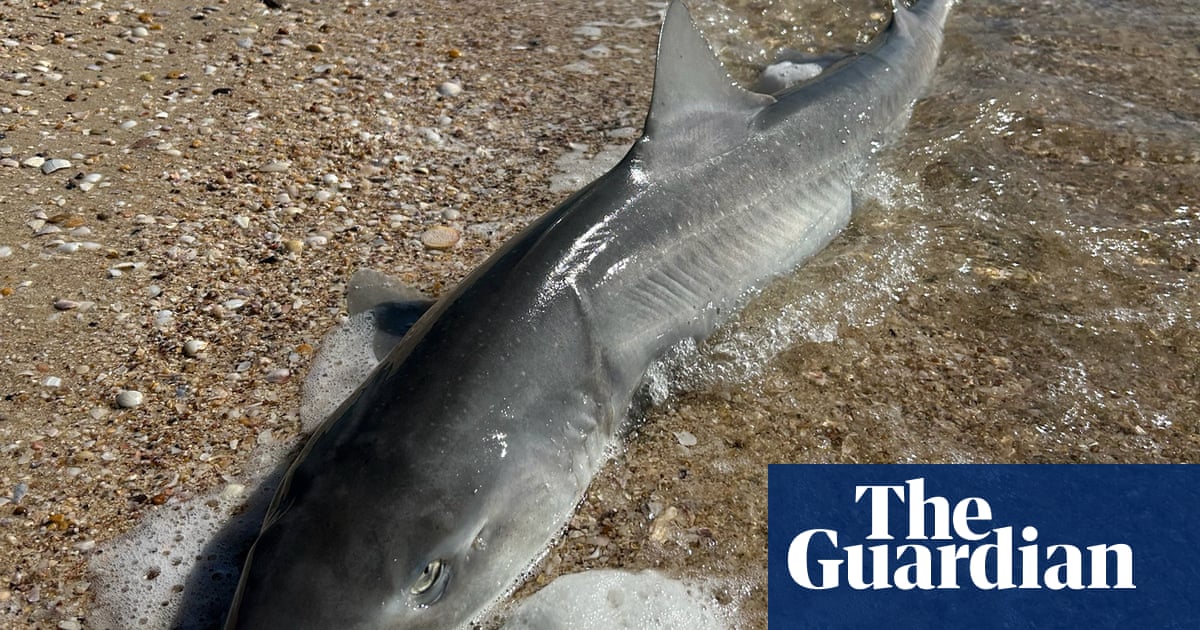Shark sightings and strandings are unusually high across South Australia amid a prolonged toxic algal bloom, but scientists say it’s too soon to link to recent shark incidents.
On Thursday, a swimmer wasbitten by a sharkat Port Noarlunga beach, 30km south of Adelaide’s CBD, one of a rising number of reported sharks swimming closer to shore – with some washing up dead on beaches.
On Tuesdayangel sharkswere reported dead on the Yorke peninsula, adding to the200-plus marine speciesreported killed by a toxic algal bloom that has affected large parts of SA’s coastline since March.
Sign up for Guardian Australia’s breaking news email
Scientists say it has been driven by a marine heatwave withwater temperatures up to 2C hotter than usual. Such events have become more frequent and intense due to climate change, causing widespread damage to ecosystems and fish communities
In May, a 3-metre-long white shark died on Adelaide’s Henley Beach, after locals found it struggling in shallow water. It was thefourth reported white sharkstranding, with others found at Port Willunga, Ardrossan and Aldinga.
Charlie Huveneers, a professor at Flinders University and expert in shark ecology and their interactions with humans, said it was likely that the unusually high number of shark observations and stranding events was connected to biotoxins from the recent algal bloom.
“We will only be able to confirm this and understand which toxin might have led to these strandings once toxicology results come back,” he said.
But Huveneers warned that while it might be tempting to try to link increased activity to the risk of shark bites, tracking data showed white sharks occurred along the metropolitan coast throughout the year, regardless of algal blooms.
South Australia’s Department of Primary Industries said while it was examining sharks and other marine life affected by the algal bloom, there was “no scientific evidence before the government to indicate that the algal bloom might make a shark attack more likely”.
“Shark encounters have always been a small but real risk for anyone entering the ocean anywhere in the world,” a spokesperson for the department said.
“It is not uncommon for white sharks to utilise coastal waters in search of food, in particular juvenile and sub-adult white sharks who are primarily fish eaters. They use such near-shore areas to hunt for small sharks, rays and skates along with larger schooling fish species including salmon, mullet and snapper.”
Sign up toBreaking News Australia
Get the most important news as it breaks
after newsletter promotion
In 2025, the state’s marine environment has been affected by a combination of high water temperatures,lack of rainand the prolonged toxic algal bloom.
“There’s been a lot of things going on, and we don’t know currently what impacts that can have on things like shark behaviour,” said Dr Briana Le Busque, University of South Australia’s environmental science program director.
More broadly, she said, people were seeing first-hand how species were affected by these major ecosystem changes. “It’s being talked about a lot,” she said.
Le Busque, a conservation psychologist who researches people’s perceptions of sharks, said there had been a noticeable change in public attitudes as these events played out.
When the white shark washed up on Henley beach, the response from the public was noticeably different, she said. There was still fear, but also concern for the animal.
“Even before it washed up – it was sort of in the shallows – we saw lots of the general population trying to help a species that, a lot of the time, people don’t necessarily like.”
The shark bite on Thursday followed a fatal shark incident in January on the state’s west coast. While such incidents were “absolutely horrible”, Le Busque said, the number that have occurred in 2025 was currentlyaligned to the annual average.
